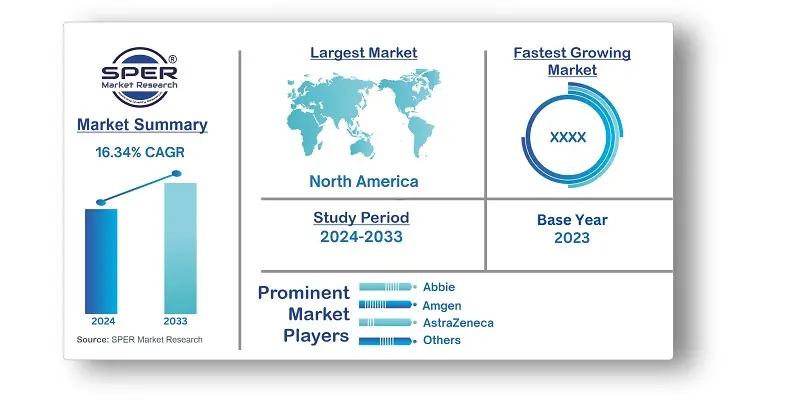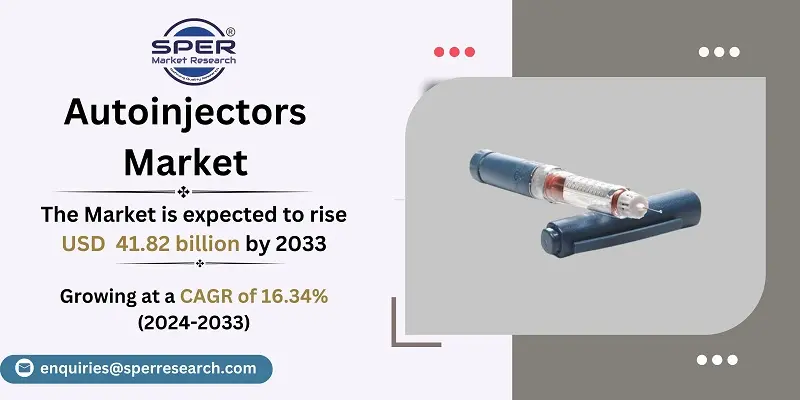
Autoinjectors Market Growth, Size, Trends, Share, Revenue, Scope, Challenges and Future Outlook
Autoinjectors Market Size– By Application, By Type, By End User- Regional Outlook, Competitive Strategies and Segment Forecast to 2033
| Published: Feb-2024 | Report ID: MEDE2412 | Pages: 1 - 210 | Formats*: |
| Category : Medical Devices | |||
- May 2022: The Qfinity autoinjector platform was introduced by Jabil Healthcare, a part of Jabil Inc. It is an easy-to-use, reusable, and modular solution for subcutaneous (SC) drug self-administration that is less expensive than competing products on the market.
- October 2022: Biocorp and BD teamed to use Biocorp's Injay technology, which gives prefilled syringes additional connectivity. It is anticipated to help BD monitor drug adherence to injectables that are self-administered.


| Report Metric | Details |
| Market size available for years | 2020-2033 |
| Base year considered | 2023 |
| Forecast period | 2024-2033 |
| Segments covered | By Application, By Type, By End User |
| Regions covered | North America, Europe, Asia - Pacific, Middle East, and Africa, and South America |
| Companies Covered | Abbie, Amgen, AstraZeneca, Bayer, Becton, Dickinson and Company, Biogen, Eli Lilly, Novartis, Teva Pharmaceuticals, and Ypsomed and various others. |
- Pharmaceutical and Biotechnology Companies
- Medical Device Manufacturers
- Healthcare Professionals
- Patients
- Hospitals and Clinics
- Pharmacies and Drug Retailers
- Patient Advocacy Groups
- Research and Academic Institutions
- Training and Education Providers
| By Application: |
|
| By Type: |
|
| By End User: |
|
- Global Autoinjectors Market Size (FY’2023-FY’2033)
- Overview of Global Autoinjectors Market
- Segmentation of Global Autoinjectors Market By Application (Rheumatoid Arthritis, Multiple Sclerosis, Anaphylaxis, and Others)
- Segmentation of Global Autoinjectors Market By Type (Disposable Autoinjectors and Reusable Autoinjectors)
- Segmentation of Global Autoinjectors Market By End User (Home Care Settings, Hospital and Clinics, and Others)
- Statistical Snap of Global Autoinjectors Market
- Expansion Analysis of Global Autoinjectors Market
- Problems and Obstacles in Global Autoinjectors Market
- Competitive Landscape in the Global Autoinjectors Market
- Impact of COVID-19 and Demonetization on Global Autoinjectors Market
- Details on Current Investment in Global Autoinjectors Market
- Competitive Analysis of Global Autoinjectors Market
- Prominent Players in the Global Autoinjectors Market
- SWOT Analysis of Global Autoinjectors Market
1.1. Scope of the report1.2. Market segment analysis
2.1. Research data source2.1.1. Secondary Data2.1.2. Primary Data2.1.3. SPER’s internal database2.1.4. Premium insight from KOL’s2.2. Market size estimation2.2.1. Top-down and Bottom-up approach2.3. Data triangulation
4.1. Driver, Restraint, Opportunity and Challenges analysis4.1.1. Drivers4.1.2. Restraints4.1.3. Opportunities4.1.4. Challenges4.2. COVID-19 Impact of the Global Autoinjectors Market
5.1. SWOT Analysis5.1.1. Strengths5.1.2. Weaknesses5.1.3. Opportunities5.1.4. Threats5.2. PESTEL Analysis5.2.1. Political Landscape5.2.2. Economic Landscape5.2.3. Social Landscape5.2.4. Technological Landscape5.2.5. Environmental Landscape5.2.6. Legal Landscape5.3. PORTER’s Five Forces5.3.1. Bargaining power of suppliers5.3.2. Bargaining power of buyers5.3.3. Threat of Substitute5.3.4. Threat of new entrant5.3.5. Competitive rivalry5.4. Heat Map Analysis
6.1. Global Autoinjectors Market Manufacturing Base Distribution, Sales Area, Type, Application6.2. Mergers & Acquisitions, Partnerships, Type Launch, and Collaboration in Global Autoinjectors Market
7.1. Global Autoinjectors Market Value Share and Forecast, By Application, 2024-20337.2. Anaphylaxis7.3. Multiple Sclerosis7.4. Rheumatoid Arthritis7.5. Others
8.1. Global Autoinjectors Market Value Share and Forecast, By Type, 2024-20338.2. Disposable Autoinjectors8.3. Reusable Autoinjectors
9.1. Global Autoinjectors Market Value Share and Forecast, By Type, 2024-20339.2. Home Care Settings9.3. Hospital and Clinics9.4. Others
10.1. Global Autoinjectors Market Size and Market Share
11.1. Global Autoinjectors Market Size and Market Share By Application (2020-2026)11.2. Global Autoinjectors Market Size and Market Share By Application (2027-2033)
12.1. Global Autoinjectors Market Size and Market Share By Type (2020-2026)12.2. Global Autoinjectors Market Size and Market Share By Type (2027-2033)
13.1. Global Autoinjectors Market Size and Market Share By End User (2020-2026)13.2. Global Autoinjectors Market Size and Market Share By End User (2027-2033)
14.1. Global Autoinjectors Market Size and Market Share By Region (2020-2026)14.2. Global Autoinjectors Market Size and Market Share By Region (2027-2033)14.2.1. Africa14.2.2. Asia – Pacific14.2.3. Europe14.2.4. Middle East14.2.5. North America14.2.6. South America
15.1. Abbie15.1.1. Company details15.1.2. Financial outlook15.1.3. Type summary15.1.4. Recent developments15.2. Amgen15.2.1. Company details15.2.2. Financial outlook15.2.3. Type summary15.2.4. Recent developments15.3. Bayer15.3.1. Company details15.3.2. Financial outlook15.3.3. Type summary15.3.4. Recent developments15.4. Becton15.4.1. Company details15.4.2. Financial outlook15.4.3. Type summary15.4.4. Recent developments15.5. Dickinson and Company15.5.1. Company details15.5.2. Financial outlook15.5.3. Type summary15.5.4. Recent developments15.6. Eli Lilly15.6.1. Company details15.6.2. Financial outlook15.6.3. Type summary15.6.4. Recent developments15.7. Novartis15.7.1. Company details15.7.2. Financial outlook15.7.3. Type summary15.7.4. Recent developments15.8. Teva Pharmaceuticals15.8.1. Company details15.8.2. Financial outlook15.8.3. Type summary15.8.4. Recent developments15.9. Ypsomed15.9.1. Company details15.9.2. Financial outlook15.9.3. Type summary15.9.4. Recent developments15.10. Others
SPER Market Research’s methodology uses great emphasis on primary research to ensure that the market intelligence insights are up to date, reliable and accurate. Primary interviews are done with players involved in each phase of a supply chain to analyze the market forecasting. The secondary research method is used to help you fully understand how the future markets and the spending patterns look likes.
The report is based on in-depth qualitative and quantitative analysis of the Product Market. The quantitative analysis involves the application of various projection and sampling techniques. The qualitative analysis involves primary interviews, surveys, and vendor briefings. The data gathered as a result of these processes are validated through experts opinion. Our research methodology entails an ideal mixture of primary and secondary initiatives.



Frequently Asked Questions About This Report
PLACE AN ORDER
Year End Discount
Sample Report
Pre-Purchase Inquiry
NEED CUSTOMIZATION?
Request CustomizationCALL OR EMAIL US
100% Secure Payment






Related Reports
Our Global Clients
Our data-driven insights have influenced the strategy of 200+ reputed companies across the globe.




















